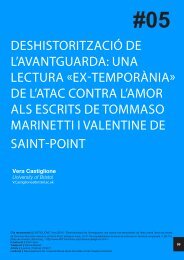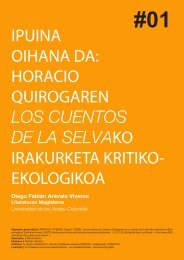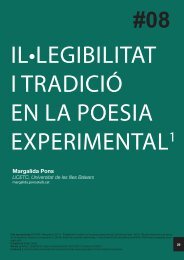03 - 452ºF
03 - 452ºF
03 - 452ºF
You also want an ePaper? Increase the reach of your titles
YUMPU automatically turns print PDFs into web optimized ePapers that Google loves.
and names in her sleep. Jack watches her in amazement, «She<br />
was only repeating some TV voice. Toyota Corolla, Toyota Celica,<br />
Toyota Cressida. Supranational names, computer-generated, more<br />
or less universally pronounceable. Part of every child’s brain noise.»<br />
(DeLillo, 1985: 155) But here, is the internalization of the consumer<br />
culture an integral part of every child’s brains only? Or is it that of the<br />
unconscious of the whole consumer society? I think DeLillo’s use<br />
of the word «child» here is either ironic or metaphorical. It can be<br />
ironic, when the first reading might be understood as that the society<br />
is not invaded by the consumer fetishism and that only children are<br />
influenced by it. Another example of irony is that when Jack notices<br />
Wilder «trying to grab items whose shape and radiance excited his<br />
system of sensory analysis» (DeLillo, 1985: 167). Do only children,<br />
like Wilder, feel mesmerized and intrigued by the colors and patterns<br />
and packaging, which make them want to shop for shopping’s own<br />
sake? I think he is cynical here, for we have seen the whole society<br />
behaving this way in the supermarket, in which reality and meaning<br />
are lost in the play of surfaces and only colors and shapes can grip<br />
the consumer’s attentions.<br />
On the other hand, if we consider DeLillo’s use of the word «child»<br />
as a metaphor, we have to consider his use of the word «old.» In<br />
the same episode when he describes Wilder’s attempts to grab<br />
the items in the mall, he also mentions that «elderly» people look<br />
lost in the dazzling «hedgerows» of the mall. I think DeLillo, here<br />
and in other places in the novel, is using the word «child» to refer<br />
to «postmodernists» and the word «old» to refer to «modernists.»<br />
Jack says, «Older people in particular were susceptible to news of<br />
impending calamity, as it was forecast on TV by grave men standing<br />
before digital radar maps» (DeLillo, 1985: 167). He, more than once,<br />
shows old people as puzzled, afraid and lost in this new postmodern<br />
society. Mr. Treadwell, the blind old man to whom Babette used to<br />
read tabloids, is an example of those old people DeLillo describes.<br />
Treadwell and his sister get lost in the mall and stay there for several<br />
days, until they are found confused and frightened. Being lost in a<br />
vast shopping center can be interpreted as late modernists’ inability<br />
to cope with the tremendous changes that occurred with the coming<br />
of the era of postmodernity.<br />
White Noise is a novel which takes you in a tour into the postmodern<br />
world of contemporary America. DeLillo has succeeded in presenting<br />
a work of art that portrays America as a fully fledged postmodern<br />
culture. For DeLillo’s characters, contemporary American reality<br />
has become completely mediated and artificial, and that is due to<br />
the intrusion of the mass media, especially of TV and radio. These<br />
technological devices have turned reality into hyperreality. People<br />
start to feel estranged by the real, and they seek refuge in the<br />
simulated. TV, with its glowing images and endless buzzes, intrudes<br />
Living in a simulacrum: how TV and the supermarket redefines reality in Don DeLillo’s White noise - Ahmad Ghashmari<br />
<strong>452ºF</strong>. #<strong>03</strong> (2010) 172-186.<br />
183










